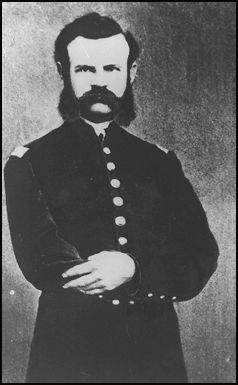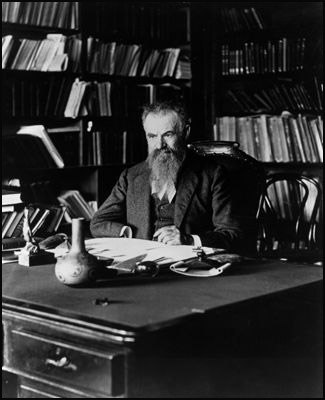| ALL HIKERS
HISTORICAL FIGURES |
JOHN WESLEY POWELL
(1834-1902)
|
It was 1869. Ten men in four boats
were about to embark on a journey that would cover almost 1,000 miles
through uncharted canyons and change the west forever. Three months later
only five of the original company plus their one-armed Civil War hero leader
would emerge from the depths of the Grand Canyon at the mouth of the Virgin
River.
Thirty five-year-old Major John Wesley Powell was that expedition's
leader. From early childhood Powell manifested deep interest in all natural
phenomena. Original and self-reliant to a remarkable degree, he early
undertook collecting and exploring trips quite unusual for a youth of his
age, and studied botany, zoology, and geology wholly without the aid of a
teacher.
He traversed various portions of Wisconsin, Illinois, Iowa, and the Iron
Mountain regions of Missouri, making collections of shells, minerals, and
general natural history objects, which led to his election in 1859 to the
secretaryship of the Illinois Natural History Society. It is said that, in
1856 when but 22 years old, he descended the Mississippi alone in a row boat
from the Falls of St. Anthony to its mouth, making collections on the way.
Again, in 1857, he rowed the whole length of the Ohio river from Pittsburg
to its mouth, and in 1858 made a like trip down the Illinois river to its
mouth and thence up the Des Moines.
 With the outbreak of the Civil War in 1860, Powell enlisted in the 20th
Illinois volunteers, and was mustered in as second lieutenant. He was for a
time stationed at Cape Girardeau and as captain of battery F of the 2nd
Illinois artillery took part in the battle of Shiloh, losing his right arm
at Pittsburg Landing. He returned to the service as soon as his wound
healed, and took part in the battles of Champion Hill and Black River
Bridge. His wife Emma Dean received permission from General Grant to
accompany her husband on the battlefield to minister to him.
With the outbreak of the Civil War in 1860, Powell enlisted in the 20th
Illinois volunteers, and was mustered in as second lieutenant. He was for a
time stationed at Cape Girardeau and as captain of battery F of the 2nd
Illinois artillery took part in the battle of Shiloh, losing his right arm
at Pittsburg Landing. He returned to the service as soon as his wound
healed, and took part in the battles of Champion Hill and Black River
Bridge. His wife Emma Dean received permission from General Grant to
accompany her husband on the battlefield to minister to him.
At the close of operations about Vicksburg he was obliged to submit to
a second operation on his arm, but returned to his post in season to take
part in the Meridian raid. Later he was made major and chief of artillery,
first, of the 17th army corps and subsequently, of the department of
Tennessee, taking part in the operations before Atlanta and in the battle of
Franklin.
He was mustered out of the service at the end of the Civil War as a
"major" in 1865 and accepted the position of professor of geology and
curator of the museum of the Illinois Wesleyan University at Bloomington,
from which institution, although not a graduate, he had previously received
the degrees of A. B. and A. M. In 1886, Powell also received the degree of
Ph.D. from Heidelberg, Germany, and that of LL.D. from Harvard University.
He also became connected with the Illinois Normal University and was widely
known throughout the state by his lectures and addresses on scientific
subjects.
It was on field trips out west that Powell began to formulate his idea
of exploring the Grand Canyon of the Colorado itself.
On May 24, 1869, Powell and nine men he recruited for a truly monumental
journey pushed from shore their boats and headed down the Green River from
Green River, Wyoming, amidst shouts and cheers from onlookers who must have
thought they would never see these 10 men again. They took provisions for
ten months.
About a month later one of the men, an Englishman named Frank Goodman,
approached the Major saying "I've had more excitement that a man deserves in
a lifetime. I'm leaving." At that point in the trip they had already lost
one boat to the rapids and most of their supplies. It must have been rather
exciting as the men knew not what to expect from one day to the next.
Goodman walked away from the expedition to a nearby settlement. He lived
for many years among the Paiute Indians of eastern Utah then later settled
in Vernal, UT, married and had a family.
The 1869 expedition continued down the Green to the confluence of the
Grand River flowing west into Utah. The two mighty rivers then merged into
the Colorado, Spanish for red river as when it rained the side tributaries
spilled their muddy red sediment into the clear green waters of the main
channel causing it to run red and thick with silt.
River runners described the Colorado in the days before Glen Canyon
Dam as "too thick to drink and too thin to plow."
During the next two months on the river, the men encountered many more
rapids that could not be run safely in Powell's estimation. He was ever
cautious, fearful they would lose the rest of the supplies and perhaps even
their lives. So they lined the boats down the side of the rapids, or
portaged boats and supplies through the rocks along the shoreline. However,
there were times when they had to run the swollen river through rapids that
surely made them pray.
At a place now called Separation Canyon, O. G. Howland, his brother
Seneca, and Bill Dunn came to the Major and spoke of "how we surely will all
die if we continue on this journey." They could only see more danger
ahead. Try as they might, they could not convince Powell to abandon the
river.
The next morning, the three men bid farewell to Powell and the remaining
five adventurers. Powell left his boat the Emma Dean at the head of
Separation Rapid in case they changed their minds. With the other five men
Powell ran what would turn out to be the first of two remaining major rapids
they would encounter. The Howlands and Dunn climbed out of the canyon
walking towards civilization only to meet their death at the hands of
Shivwits Indians who mistook them for miners that had killed a Hualapai
woman on the south side of the river. At least that was the story Powell
heard the next year when he visited the Shivwits area with Mormon Scout
Jacob Hamlin.
It was ironic they parted company then as two days later Powell
and his men reached the mouth of the Virgin River (now under Lake Mead) and
were met by settlers fishing from the river bank. The adventurers had not
been heard from in three months and were presumed dead.
Powell had completed what he sought to do ... explore and confirm his
theory on the Grand Canyon of the Colorado, a region up to that time almost
wholly unknown and concerning which there were many vague and often wild
rumors. His theory was the river preceded the canyons and then cut them as
the Plateau rose.
Returning a national hero to Illinois, Powell promptly hit the lecture
circuit then raised funds for a second expedition in 1871 which would
produce what the first did not - a map and scientific publications.
|
 Powell's active work as a geologist eventually gave way to a new career
in government. In March 1881, he assumed the directorship of the U.S.
Geological Survey when the first director Clarence King resigned. He
served for 13 years. Until his own voluntary retirement from the survey
in 1894, Powell also was the head of the Bureau of Ethnology which he
continued to run until his death in 1902 despite failing health mainly
due to his amputated arm which was a great source of periodic pain.
Though between 1894 and 1902 Powell spent increasingly less time running
the Bureau and more time on his philosophical/ethnographic writing.
Powell's active work as a geologist eventually gave way to a new career
in government. In March 1881, he assumed the directorship of the U.S.
Geological Survey when the first director Clarence King resigned. He
served for 13 years. Until his own voluntary retirement from the survey
in 1894, Powell also was the head of the Bureau of Ethnology which he
continued to run until his death in 1902 despite failing health mainly
due to his amputated arm which was a great source of periodic pain.
Though between 1894 and 1902 Powell spent increasingly less time running
the Bureau and more time on his philosophical/ethnographic writing.
Powell died from a cerebral hemorrhage at his summer home in Haven,
Maine, Sept. 23, 1902. His wife Emma Dean, whom he married in 1862, and
their only child, a daughter named Mary Dean, survived him. With the
honors bestowed to a Civil War veteran, Powell is buried in Arlington
Cemetery.
People who were on Powell's First trip
down the Colorado River in 1869:
- Major Powell
- Walter Powell, his brother
- Jack Sumner
- Andy Hall
- William Rhodes Hawkins
- George Bradley
- Frank Goodman (left after first 3 weeks; first 80
miles)
The following three left at Separation
Canyon near the end of the journey and met an untimely death allegedly by
Shivwits Indians seeking three men who killed an Indian woman:
- O.G. Howland
- Seneca Howland, brother to O. G. (Oramel)
- William H. "Bill" Dunn
Participants on Powell's Second trip down the Colorado
River in 1871:
- Major Powell
- Walter Clement Powell, cousin and assistant
photographer
- Professor A. H. Thompson, Powell's brother-in-law
- Frederick S. Dellenbaugh
- S.V. Jones
- E.O. Beaman, photographer
- Jack Hillers, became photographer after Beaman left
- J.F. Steward
- F.M. Bishop
- Frank Richardson
- Andrew Hattan
| This story furnished courtesy
of: |
John Wesley Powell Memorial Museum
#6 N. Lake Powell Blvd.
(corner of N. Lake Powell Blvd. and North Navajo Drive)
P.O. Box 547
Page, Arizona 86040
www.powellmuseum.org |
| Photo Credits: Smithsonian Institution |
The Powell Museum Bookstore carries a variety of
books and tapes about Major Powell. |
MAIN INDEX
|
BACK TO HISTORICAL FIGURES
|
Copyright © Richard M. Perry, 2004-2024. All rights reserved. This web site, its text, and pictures may not be
copied without the express written consent of Richard
M. Perry. |
|
|
|